Size
Does size matter?
For most winter sports enthusiasts, the size of a ski area is an important criterion when choosing a destination for their holidays. The size of a ski area is mainly determined by the total length of runs offered and it is undisputed: the longer the better. The size of the ski area and the variety of slopes are also important for the day guests, according to a study by the Austrian Cable Car Association.
Potential criteria for measuring the size of ski areas
When comparing the size of ski areas, the first question is how to measure this size? There are several variables to choose from:
The total length of runs (incl. pistes, catwalks and ski routes) in kilometres is the standard in Europe so far - with all its problems described.
Conclusion: The length of runs should be a central factor in determining the size of a ski area and is therefore taken into account.
While in Central Europe the number of runs is of minor importance, it is advertised in other parts of the world, especially in the eastern part of North America. This value is effectively promoted by the splitting of runs into upper, middle and lower sections.
Conclusion: The number of runs should not be taken into account for size measurement, not only because of inconsistent counting methods. It is also not a reliable indicator of the diversity of the terrain, as in some ski areas many parallel runs of identical character increase the number.
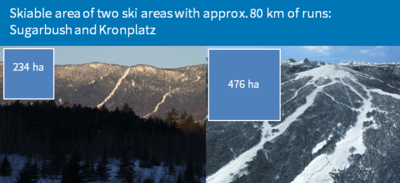
In North America, the skiable area is the indicator for the size of a ski area. It usually includes both groomed pistes and ungroomed areas off-piste that have been opened for skiing. In North America, areas of rocks, trees and buildings are often included - or those that are not accessible by lift.
Conclusion: The skiable area should be taken into account when measuring the size, as it includes the width of pistes. The following figures illustrate that width makes a difference.
A detailed description of the concept for determining the skiable area, which combines the different philosophies in Europe and North America, can be found here.
A key indicator worldwide, especially in East Asia and Scandinavia. However, it is losing importance due to the ongoing restructuring of the lift system in many areas.
Conclusion: The number of lifts is not appropriate to measure the actual size. In Scandinavia it is not uncommon that three parallel surface lifts lead to a piste where there is just one chair lift elsewhere. Some lifts open up only 100 metres of piste, some other a full 20 kilometres of pistes.
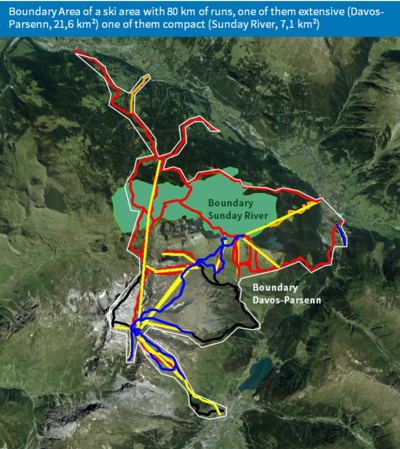
When you talk about the "size" of a country, you usually don't mean the length of the highway or fiber optic network there, but its area. Consequently, Russia is the "largest" country in the world. In this respect, when considering the size of ski areas, it is also necessary to consider their area. This includes the area that cannot be left without crossing a piste or a lift. Some North American ski resorts do not indicate the skiable area, but the total area of the resort.
Conclusion: The boundary area is relevant when determining the size of a ski area and should be taken into account. For example, a large ski area with a relatively thin network of pistes can appear larger than one with a longer length of runs in a smaller area. The figure on the following page illustrates this using the example of the Davos Parsenn and Sunday River ski resorts, both measuring around 80 kilometres of pistes - with a very different boundary area.
Picture: The boundary area of the Sunday River ski area is shown as a green area, the Davos-Parsenn area is framed in white.

Even ski areas that have an identical length of runs, boundary area and skiable area can be significantly different. The extent is the largest linear distance between two points in the ski area. So far, the extent has only been communicated sporadically.
Conclusion: The larger the extent, the higher the probability of changes in the landscape, so it should be considered as a complementary factor in size measurement.
Picture: The extent of the ski resort Winter Park is shown as a green area, the aerial view shows the ski area Hochkönig.
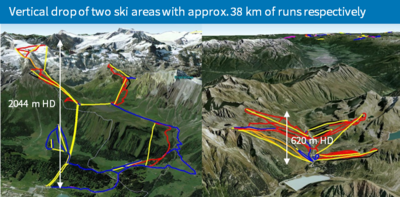
Ski areas not only expand in terms of width but also in terms of elevation. The maximum vertical drop plays an important role in the communication of American ski resorts, but hardly in Europe, even though European ski resorts have much greater differences in elevation. And the greater this difference, the more "alpine" a ski area can be.
Conclusion: If size is defined as for human beings measuring the difference between a person's head and his toes, then ski areas that have a particularly long way from the highest to the lowest point can also be described as particularly large. One reason for this is that you can experience this vertical drop by passing through different climate zones (from the glacier to the forest belt) and experiencing large differences in temperature. Therefore, the entire vertical drop between the lowest and the highest part of the piste should be included in the size measurement (the uninterrupted vertical drop is taken into account via the longest run).
Picture: The left picture shows the Titlis with its 2,044 meters of vertical drop, the right picture shows the Kühtai with its 620 meters of vertical drop.

Even ski areas that have the same total length of runs, the same skiable area, the same extent and the same vertical drop can still differ significantly from each other in their topography. It is possible to fit 30 kilometres of pistes on a mountain side with 400 metres of vertical drop, completely exposed in one direction, but they can also extend over several mountain sides exposed in various directions. In the latter case, a change of perspective makes such an area appear much larger, despite identical statistics.
The two ski resorts Holimont and Winterberg each have about 24 km of runs, about 130 hectares and about 200 metres of vertical drop. But all the pistes of Holimont are located on a long north slope, while in Winterberg seven peaks and 15 mountain sides are accessible.
Conclusion: With the criterion topography, the structure of the terrain, which is not measured by any other indicator, can also be included in the valuation of the size, expressed in the number of different peaks and accessible mountain sides. Therefore the topography should be taken into account.
The hourly transport capacity in persons per hour is often communicated, but rarely in advertising. Almost exclusively in North America, the vertical transport capacity of the lifts is communicated from time to time.
Conclusion: For the guest, transport capacity only plays a role in relation to the number of skiers because it influences waiting times. However, it has no relevance for the size.
This indicator is used to measure the success of a ski area and its market share.
Conclusion: For the guest, the number of skier visits in a ski area is irrelevant as a criterion for its size. Even if the number of visits in relation to other key figures may allow qualitative statements to be made.
The longest runs of a ski area are something like the little brother of the total length of runs. Attributes like "the longest run in Europe" can compensate for a certain amount of total run length in terms of image. Runs over ten, twelve kilometres of uninterrupted length are a great source of fascination and some of these runs bear names that skiers have heard before: Parsenn, Sarenne or the Hochjoch-Totale are just a few of them.
Conclusion: The longest run should find its way into the evaluation of the size of a ski area, as it can be a flagship for a ski area.
The following criteria remain for measuring the size of a ski area:
- Total length of runs (ski runs or organised ski area, i.e. length of runs, ski routes, special areas and catwalks in kilometres)
- Skiable area (marked and secured area within the ski area boundaries in hectares)
- Boundary area (area enclosed by lifts and pistes in square kilometres)
- Extent of the ski area (largest linear distance between two points within the ski area in kilometres)
- Vertical drop (difference between the highest and lowest point in the piste network in metres)
- Topography (number of peaks and mountain sides in the ski area)
- Longest run not interrupted by ascents in kilometers
But how can these very different features be combined into a single value for the size of a ski area? The first question to be answered is how much weight the listed criteria have for the perceived size of a ski area. This perception should be represented as accurately as possible by the size value.
An online survey was therefore conducted as the basis for such a weighting. The results are shown in the following diagram.
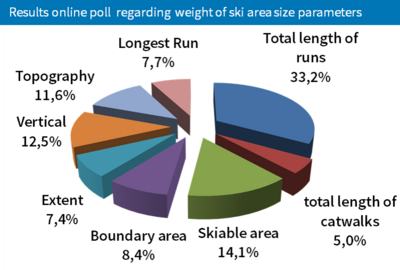
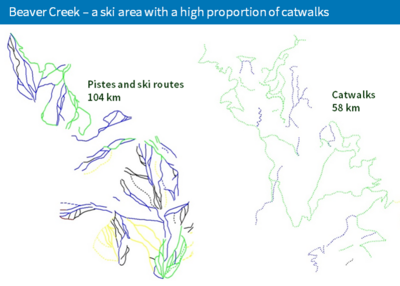
As part of the online survey, the criteria were first explained (as explained above) and finally the following question was asked: "Please assess how important the criteria shown are to you with regard to the actual perceived size of a ski area. You can award a total of 100 points. These can be placed completely on one criterion or distributed as desired to the different criteria."
The criterion total length of runs was subdivided into length of runs, special areas and ski routes on the one hand and length of catwalks on the other hand. This was done to reflect the fact that catwalks can be used to produce "length" much easier, a length, however, which in its significance for the perceived size of a ski area is much less weighted than that of the pistes and ski routes.
Beaver Creek in Colorado is an example of a ski area that has a lot to offer in terms of kilometres of catwalks with more than 1/3 of the total length of runs being catwalks.
Whereas the category "length of runs, special areas and ski routes" received an average of 33.2 percent of the points to be awarded and is thus, as expected, the most important single criterion, the catwalks received only 5.0 percent. The second most important criterion is the skiable area, closely followed by vertical drop and topography. A little bit behind followed by the boundary area, the extent and the longest run with values between 7.4 and 8.5 percent.
Using these survey results, the values of the individual criteria can be weighted and combined into a single value for the size of the ski area. We have given this value the name Skimiles. How the Skimiles are calculated is explained here.

